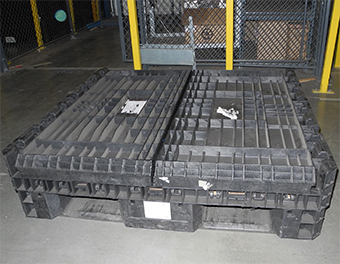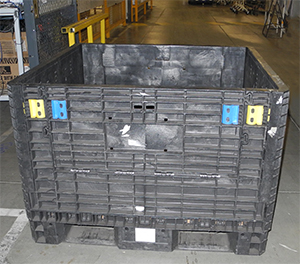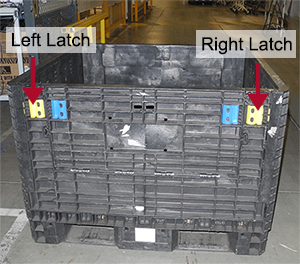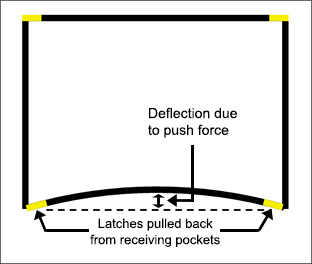Alert: Collapsible plastic bulk containers
Learn about the rules and regulations to prevent injuries when working with collapsible plastic bulk containers.
Background
Open-top, collapsible plastic bulk containers offer a convenient way to store and transport a wide range of items. They are widely used in numerous types of workplaces to store and transport parts, items or materials at a location or from one location to another.
Types of Workplaces
- aerospace
- agriculture/Poultry
- apparel
- appliance
- automotive
- bakery
- electronics
- food/Beverage
- manufacturing
- pharmaceutical
- produce
- storage
- warehousing
- waste Management
Collapsible plastic bulk containers come in different sizes. For reduced storage space and ease of transportation, the four sides can be collapsed inwardly so the two sets of opposing sides lie neatly on top of each other in the horizontal position. Photo 1 and Photo 2 show a collapsible plastic bulk container in collapsed and set-up modes respectively.

Photo 1: A collapsible plastic bulk container in collapsed mode

Photo 2: A collapsible plastic bulk container in set up/vertical mode
This hazard alert is intended to help workplace parties, including manufacturers and suppliers, be aware that these types of collapsible plastic bulk containers can suddenly collapse inward. This sudden collapse inward can be caused by pushing against the side of the container and the container coming into contact with another object; or if there is enough resistance caused by the load in the container and/or the condition of the surface area that the container is being moved on.
Hazard summary
A worker at a workplace attempted to move a collapsible plastic bulk container by pushing it to try to make it slide on the floor. When the container came into contact with other containers behind it, the side of the container the worker was pushing against suddenly collapsed inward, causing the worker to fall head-first into the bin. The worker sustained serious neck injuries as a result.
Two of the sides of a collapsible plastic bulk container have two latches that, when engaged, secure the sides in the set up/vertical position. Photo 3 shows the latches (yellow) on a side of a container. The right latch and the left latch are identical and are a mirror-image of each other.

Photo 3: Latches to help secure a side in the set up/vertical position

Figure 1: Latches Pulled Back from Receiving Pockets due to Deflection in Side
A push force applied to a latched side of a collapsible plastic bulk container will result in some inward deflection in the side. The amount of deflection depends on several variables, including the container material properties, the amount or magnitude of push force, and how much the container is restricted from moving. The deflection can cause the engaged portion of the latches to be pulled back, as illustrated in Figure 1, to the extent the latches slip off the receiving pocket, allowing the side to collapse.
Protective measures
The Occupational Health and Safety Act (OHSA) requires employers to provide information, instruction and supervision to a worker to protect the health or safety of the worker [clause 25(2)(a)]. Therefore, employers must provide information, instruction and supervision to workers to address the hazard of sudden inward collapse of collapsible plastic bulk containers.
Pursuant to clause 45(a) of the Regulation for Industrial Establishments, material, articles or things, required to be lifted, carried or moved, shall be lifted, carried or moved in such a way and with such precautions and safeguards, including protective clothing, guards or other precautions as will ensure that the lifting, carrying or moving of the material, articles or things does not endanger the safety of any worker. Therefore, employers must take precautions to ensure that collapsible plastic bulk containers are moved in a manner that will not endanger a worker. This may include developing safe work procedures for moving collapsible plastic bulk containers, paying particular attention to any force being applied to the latched/collapsible sides of the containers.
The OHSA requires employers to take every precaution reasonable in the circumstances for the protection of any worker [clause 25(2)(h)]. This may include following the instructions from the manufacturers of collapsible plastic bulk containers on the safe movement of the containers.
Legislative and regulatory requirements
Section 45 of the Regulation for Industrial Establishments (Regulation 851): Material, articles or things,
- required to be lifted, carried or moved, shall be lifted, carried or moved in such a way and with such precautions and safeguards, including protective clothing, guards or other precautions as will ensure that the lifting, carrying or moving of the material, articles or things does not endanger the safety of any worker; [clause 45(a)]
Under section 25 of the OHSA, the employer must:
- provide information, instruction and supervision to a worker to protect the health or safety of the worker; [clause 25(2)(a)]
- take every precaution reasonable in the circumstances for the protection of a worker; [clause 25(2)(h)]
For more information
This resource does not replace the Occupational Health and Safety Act (OHSA) and its regulations and should not be used as or considered legal advice. Health and safety inspectors apply and enforce these laws based on the facts they find in the workplace.